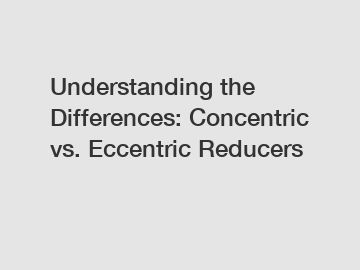Understanding the Differences: Concentric vs. Eccentric Reducers
Understanding the Differences: Concentric vs. Eccentric Reducers.
When it comes to industrial piping systems, reducers play a crucial role in connecting pipes of different sizes. Among the various types of reducers available, concentric and eccentric reducers are commonly used in piping applications. While both serve the same purpose of connecting pipes with different diameters, they have distinct features and applications. Understanding the differences between concentric and eccentric reducers is essential for choosing the right option for your piping system.
Concentric Reducers: A Seamless Transition.

Concentric reducers have a symmetrical design, with the centerline of the inlet and outlet pipes aligned. This results in a smooth and gradual reduction in diameter, providing a seamless transition for fluid flow. The gradual reduction helps in reducing turbulence, pressure drop, and erosion in the piping system. Concentric reducers are typically used when there is a need to maintain the same level of fluid pressure and flow rate throughout the piping system. They are ideal for applications where space constraints are not a concern.
Eccentric Reducers: Managing Flow and Drainage.
Unlike concentric reducers, eccentric reducers have an offset centerline, with the inlet and outlet pipes not aligned. This design feature helps in managing flow and drainage issues in the piping system. Eccentric reducers are commonly used in applications where there is a need to prevent air or gas pockets from forming in the piping system. They are also preferred in applications where drainage is crucial, such as in sewage or wastewater systems. The offset design of eccentric reducers allows for efficient fluid flow and ensures proper drainage, making them suitable for various industrial applications.
Choosing the Right Option for Your Piping System.
When selecting between concentric and eccentric reducers for your piping system, several factors need to be considered. The type of fluid being transported, the flow requirements, space constraints, and drainage considerations all play a role in determining the most suitable option. Consultation with piping experts and engineers is crucial in choosing the right type of reducer for your specific application. Whether you require a seamless transition for fluid flow or efficient drainage and flow management, understanding the differences between concentric and eccentric reducers is essential for optimizing your piping system's performance.
Contact Us for Expert Advice.
If you are unsure about which type of reducer is best suited for your piping system, feel free to reach out to us for expert advice and guidance. Our team of experienced professionals can help you assess your requirements and recommend the most suitable option for your application. Understanding the differences between concentric and eccentric reducers is the first step towards ensuring the efficient and reliable operation of your industrial piping system. Contact us today to learn more about our products and services.
In conclusion, concentric and eccentric reducers serve distinct purposes in industrial piping systems, with each type offering unique advantages. By understanding the differences between these two types of reducers, you can make an informed decision when selecting the right option for your application. For expert advice and assistance in choosing the most suitable reducer for your piping system, do not hesitate to contact us.
For more elbow plumbing, reducers pipe fittings, carbon steel weld neck flangeinformation, please contact us. We will provide professional answers.

Comments
0